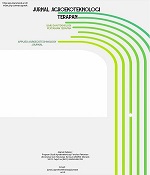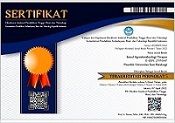The Impact of Postharvest Handling on the Nutmeg Seed (Myristica fragrans Houtt) Quality
DOI:
https://doi.org/10.35791/jat.v4i2.51384Abstract
The amount of aflatoxin contamination has exceeded the maximum limit for sales in the European market, which is 10 µg/kg of nutmeg seed products with mold according to SNI standards not exceeding 8%. In order to obtain nutmeg seed products of SNI 01-0007-1993 standard quality, pre-harvest, harvest, and post-harvest handling are carried out in the right manner and at the right time. The aims of the study were to determine harvesting techniques and drying methods to produce quality nutmeg products and to recommend efficient and applicable harvesting and drying methods that meet the requirements of SNI standards. The research method used a Completely Randomized Design (CRD) with two factors, Factor A how to harvest (picked, using nets, and collected), Factor B how to dry (electric oven, drying racks, and tarpaulin), repeated 3 times so that 27 experimental units were obtained. Parameters observed included: 1. Analysis of Water Content, 2. Physical Characteristics, and 3 Physical Characteristics of Mold. The results showed that the water content of nutmeg seeds before drying ranged from 80.72 – 82.00%, after the drying process the moisture content of nutmeg seeds ranged from 7.50 – 9.67%. The highest water content was in sample A1B2, while the lowest water content was in sample A3B2. In general, the indication of the water content of nutmeg seeds for each treatment is less than 10% so it meets the Indonesian National Standard, namely the maximum 10%.
Keywords: Nutmeg, how to harvest, drying, moisture, mold.
Abstrak
Jumlah cemaran aflatoksin tidak melebihi batas maksimal untuk diperdagangkan di pasar Eropa, yaitu 10 µg/kg atau produk biji pala yang berkapang sesuai persyaratan standar SNI tidak melebihi 8%. Untuk mendapatkan produk biji pala, berkualitas standar SNI 01-0007-1993 maka penanganan prapanen, panen dan pascapanen dilakukan dengan cara dan pada waktu yang tepat. Penelitian bertujuan untuk menentukan teknik panen dan cara pengeringan untuk menghasilkan produk biji pala berkualitas dan untuk merekomendasi cara panen dan pengeringan yang efisien dan aplikatif memenuhi syarat standar SNI. Metode penelitian menggunakan Rancangan Acak Lengkap (RAL) dengan dua faktor, Faktor A cara panen (dipetik, menggunakan jaring, dan dipungut), Faktor B cara pengeringan (oven listrik, rak pengering/para-para, dan terpal), diulang sebanyak 3 kali, sehingga diperoleh 27 satuan pecobaan. Parameter yang diamati meliputi : 1. Analisis Kadar Air, 2. Karakteristik Fisik Biji Pala, dan 3 Karakteristik Fisik Kapang. Hasil penelitian menunjukkan bahwa kadar air biji pala sebelum dikeringkan berkisar antara 80.72 – 82.00%, setelah dilakukan proses pengeringan kadar air biji pala berkisar antara 7.50 – 9.67%. Kadar air tertinggi pada sampel A1B2, sedangkan kadar air terendah pada sampel A3B2. Umumnya indikasi kadar air biji pala setiap perlakuan kurang dari 10% sehingga telah memenuhi Standar Nasional Indonesia yakni maksimum 10%. Demikian halnya pengamatan karakteristik fisik biji pala dan kapang untuk semua perlakuan relatif memenuhi Standar Nasional Indonesia (SNI).
Kata Kunci : Biji Pala, Cara Panen, Pengeringan, Kadar Air, Kapang.
Downloads
Published
How to Cite
Issue
Section
License
Copyright (c) 2023 Gabriela Sampelani Joseph, Lucia Cecilia Mandey, Gregoria S.S Djarkasi

This work is licensed under a Creative Commons Attribution-NonCommercial 4.0 International License.

This work is licensed under a Creative Commons Attribution-NonCommercial 4.0 International License.




















